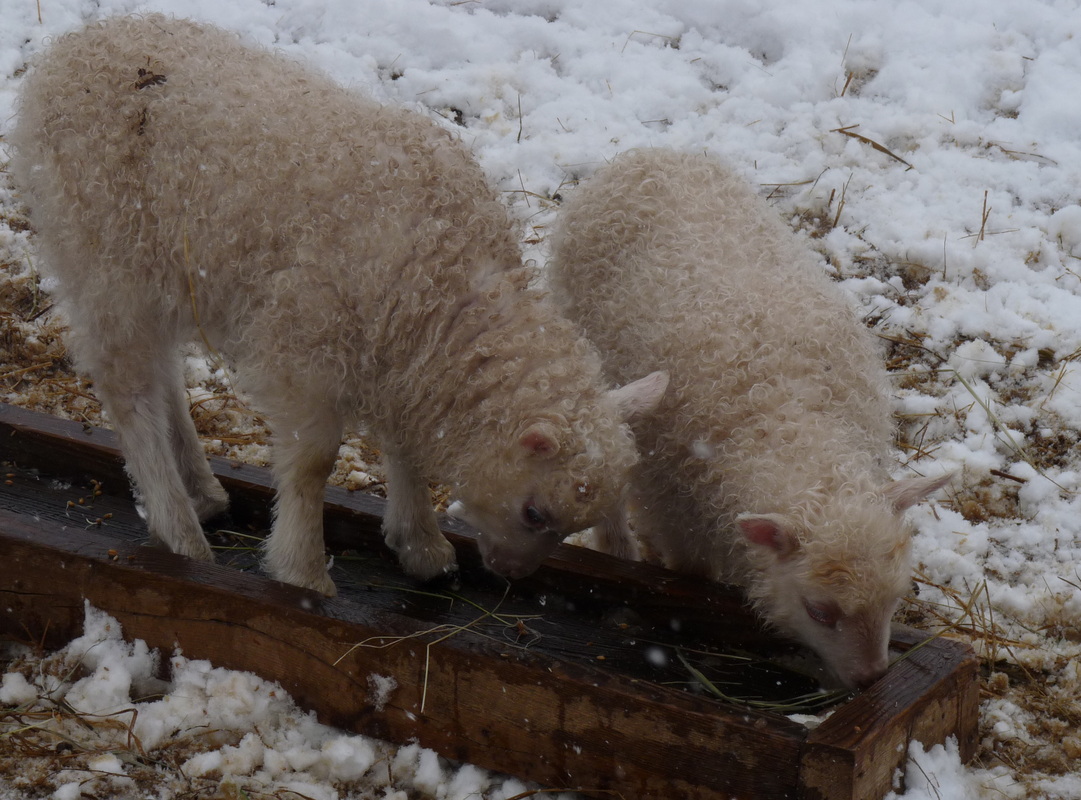Selenium (Se):
Selenium is a trace mineral crucial to proper immune and reproductive function in sheep and goats. It is needed for proper growth, fertility and prevention of selenium-deficiency diseases (Underwood, 1981, p. 149).
Some deficiency diseases and symptoms include white muscle disease (dietary muscular dystrophy), infertility, unthriftiness and weak lambs at birth or shortly thereafter (NRC, 1985, pp. 20-21; Underwood, 1981, pp. 149-150)
Selenium can accumulate to toxic levels although this is rare over much of North America. Chronic toxicity results in loss of wool, lack of vitality, emaciation, stiff joints and erosion of joints, atrophy of the heart (note that deficiency may produce heart defects also). Other symptoms include sloughing of hooves, reduction in reproduction and possibly death. One term for this toxicity is "Alkali" disease. In cases of toxicity, feeding low-selenium forage allows the body to eliminate the excess (NRC, 1985, p. 22; Underwood, 1981, pp. 160-161).
No mineral stands alone in the body. Selenium appears to work synergistically with copper, feeding selenium to animals on marginal copper diets improved copper levels (NRC, 1985, p. 21). Selenium and vitamin E work together, without vitamin E, the body cannot use selenium. However, forage should contain adequate levels of vitamin E. Reasons for vitamin deficiency include feeding animals hay that has been stored for long periods. This can cause vitamin levels to degrade, supplementation of vitamin E may be necessary in winter or feedlot situations. Both vitamin E and selenium function as antioxidants in the body (Underwood, 1981, pp. 149-150).
Selenium can interact with several minerals, including iron and sulfur, making it unavailable during digestion and contributing to deficiency (Pitzen, 1993, p. 9)
Form of selenium ingested contributes to availability in the body. The selenite form of selenium is not very well-absorbed by ruminants, meaning it is not particularly toxic but also not particularly useful for proper use in the body or to correct deficiencies.
Methionine (chelated) forms are more available (Underwood, 1981, p. 162).
References:
National Research Council. 1985. Nutrient Requirements of Sheep. Wash. DC: Natl. Academy Press.
Pitzen, D. 1993. "The Trouble with Iron". Feed Mgmt 44(6) pp. 9-10.
Underwood, E. 1981. The Mineral Nutrition of Livestock. England: Commonwealth Agricultural Bureau.
Selenium is a trace mineral crucial to proper immune and reproductive function in sheep and goats. It is needed for proper growth, fertility and prevention of selenium-deficiency diseases (Underwood, 1981, p. 149).
Some deficiency diseases and symptoms include white muscle disease (dietary muscular dystrophy), infertility, unthriftiness and weak lambs at birth or shortly thereafter (NRC, 1985, pp. 20-21; Underwood, 1981, pp. 149-150)
Selenium can accumulate to toxic levels although this is rare over much of North America. Chronic toxicity results in loss of wool, lack of vitality, emaciation, stiff joints and erosion of joints, atrophy of the heart (note that deficiency may produce heart defects also). Other symptoms include sloughing of hooves, reduction in reproduction and possibly death. One term for this toxicity is "Alkali" disease. In cases of toxicity, feeding low-selenium forage allows the body to eliminate the excess (NRC, 1985, p. 22; Underwood, 1981, pp. 160-161).
No mineral stands alone in the body. Selenium appears to work synergistically with copper, feeding selenium to animals on marginal copper diets improved copper levels (NRC, 1985, p. 21). Selenium and vitamin E work together, without vitamin E, the body cannot use selenium. However, forage should contain adequate levels of vitamin E. Reasons for vitamin deficiency include feeding animals hay that has been stored for long periods. This can cause vitamin levels to degrade, supplementation of vitamin E may be necessary in winter or feedlot situations. Both vitamin E and selenium function as antioxidants in the body (Underwood, 1981, pp. 149-150).
Selenium can interact with several minerals, including iron and sulfur, making it unavailable during digestion and contributing to deficiency (Pitzen, 1993, p. 9)
Form of selenium ingested contributes to availability in the body. The selenite form of selenium is not very well-absorbed by ruminants, meaning it is not particularly toxic but also not particularly useful for proper use in the body or to correct deficiencies.
Methionine (chelated) forms are more available (Underwood, 1981, p. 162).
References:
National Research Council. 1985. Nutrient Requirements of Sheep. Wash. DC: Natl. Academy Press.
Pitzen, D. 1993. "The Trouble with Iron". Feed Mgmt 44(6) pp. 9-10.
Underwood, E. 1981. The Mineral Nutrition of Livestock. England: Commonwealth Agricultural Bureau.
By Alethea Kenney, Copyright 2021-2025. Do not copy or reprint without permission
